BIT244 IT and Business Crime: Fake News Problems and Legal Remedies
VerifiedAdded on 2023/04/04
|12
|2524
|382
Report
AI Summary
This report provides an in-depth analysis of IT and business crimes, with a specific focus on the proliferation of fake news in the modern digital landscape. It examines the techniques employed to generate and disseminate false information, highlighting the potential damage caused to the public and various sectors. The report further explores the legal actions undertaken by different countries to combat the spread of fake news, including legislative measures and penalties for offenders. Real-world examples and case studies are provided to illustrate the impact of misinformation and the challenges in addressing this growing concern within the realms of technology and business.
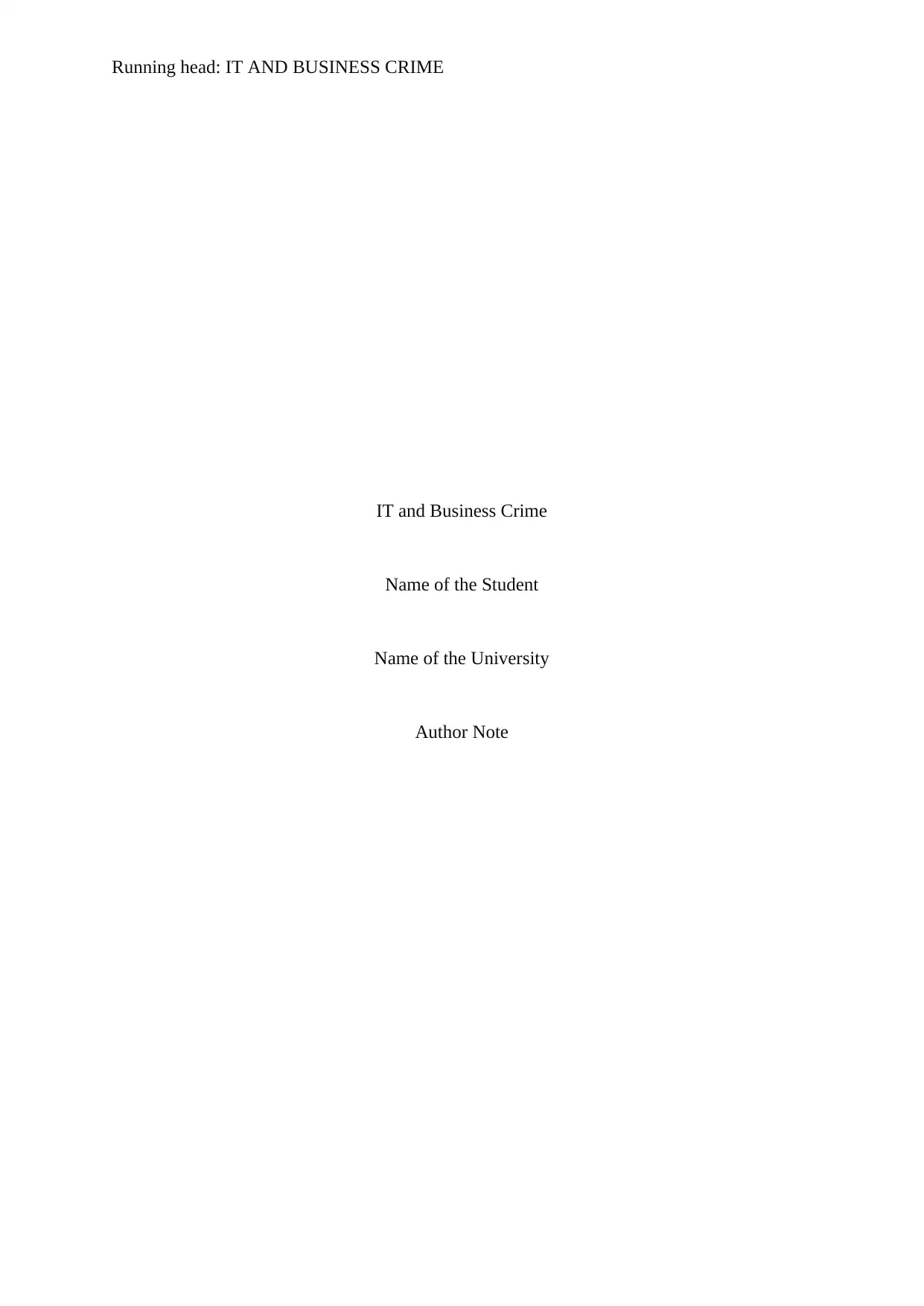
Running head: IT AND BUSINESS CRIME
IT and Business Crime
Name of the Student
Name of the University
Author Note
IT and Business Crime
Name of the Student
Name of the University
Author Note
Paraphrase This Document
Need a fresh take? Get an instant paraphrase of this document with our AI Paraphraser

1IT AND BUSINESS CRIME
Executive Summary
This report extensively discuss about IT and business crimes in the modern era. The report
highlights facts and issues of fake news, the techniques used to generate fake and the
potential damage caused to the public. Thus with the wide and rapid spread of fake news,
countries have taken up legal actions to prevent spreading of fake news.
Executive Summary
This report extensively discuss about IT and business crimes in the modern era. The report
highlights facts and issues of fake news, the techniques used to generate fake and the
potential damage caused to the public. Thus with the wide and rapid spread of fake news,
countries have taken up legal actions to prevent spreading of fake news.
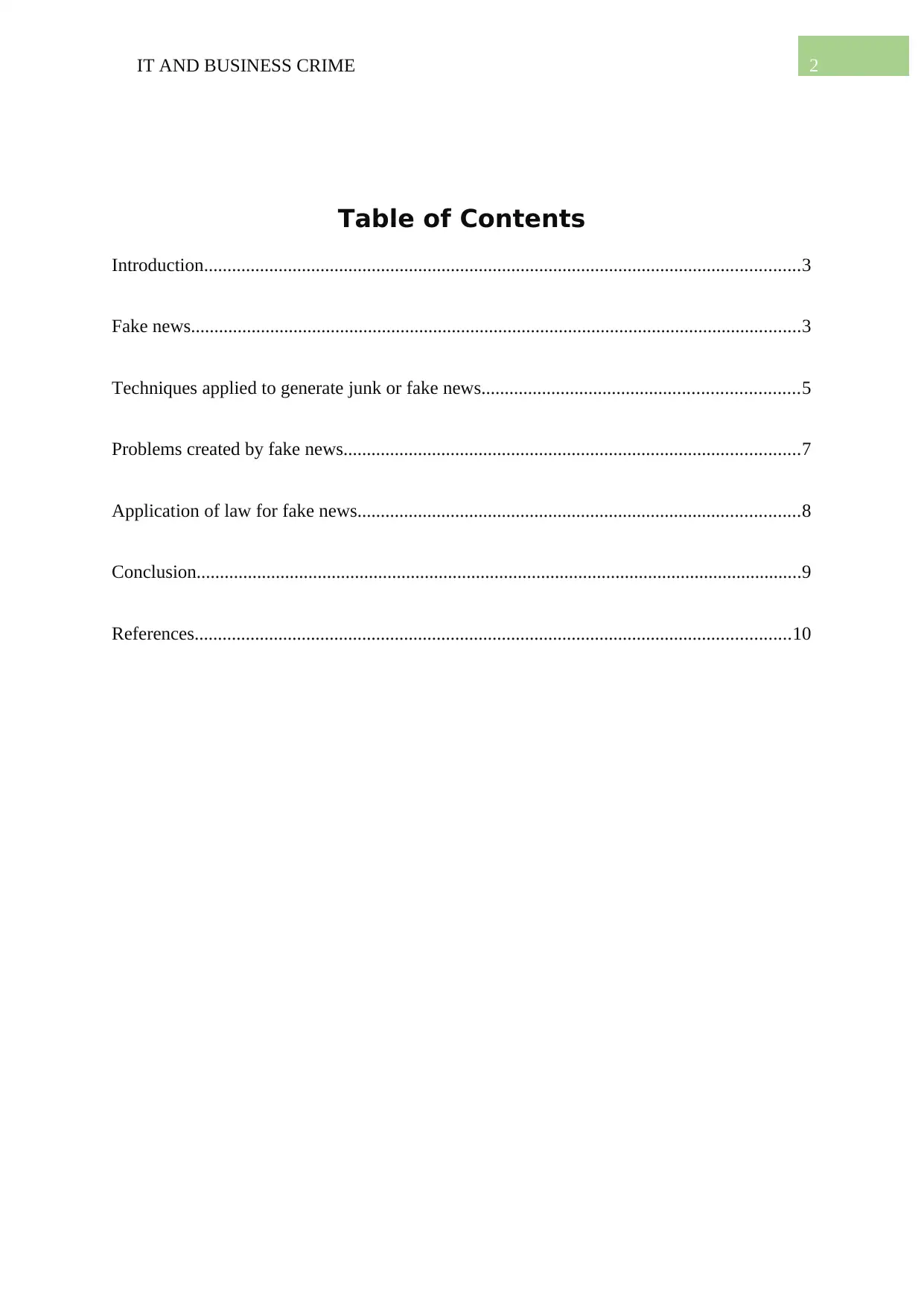
2IT AND BUSINESS CRIME
Table of Contents
Introduction................................................................................................................................3
Fake news...................................................................................................................................3
Techniques applied to generate junk or fake news....................................................................5
Problems created by fake news..................................................................................................7
Application of law for fake news...............................................................................................8
Conclusion..................................................................................................................................9
References................................................................................................................................10
Table of Contents
Introduction................................................................................................................................3
Fake news...................................................................................................................................3
Techniques applied to generate junk or fake news....................................................................5
Problems created by fake news..................................................................................................7
Application of law for fake news...............................................................................................8
Conclusion..................................................................................................................................9
References................................................................................................................................10
⊘ This is a preview!⊘
Do you want full access?
Subscribe today to unlock all pages.

Trusted by 1+ million students worldwide
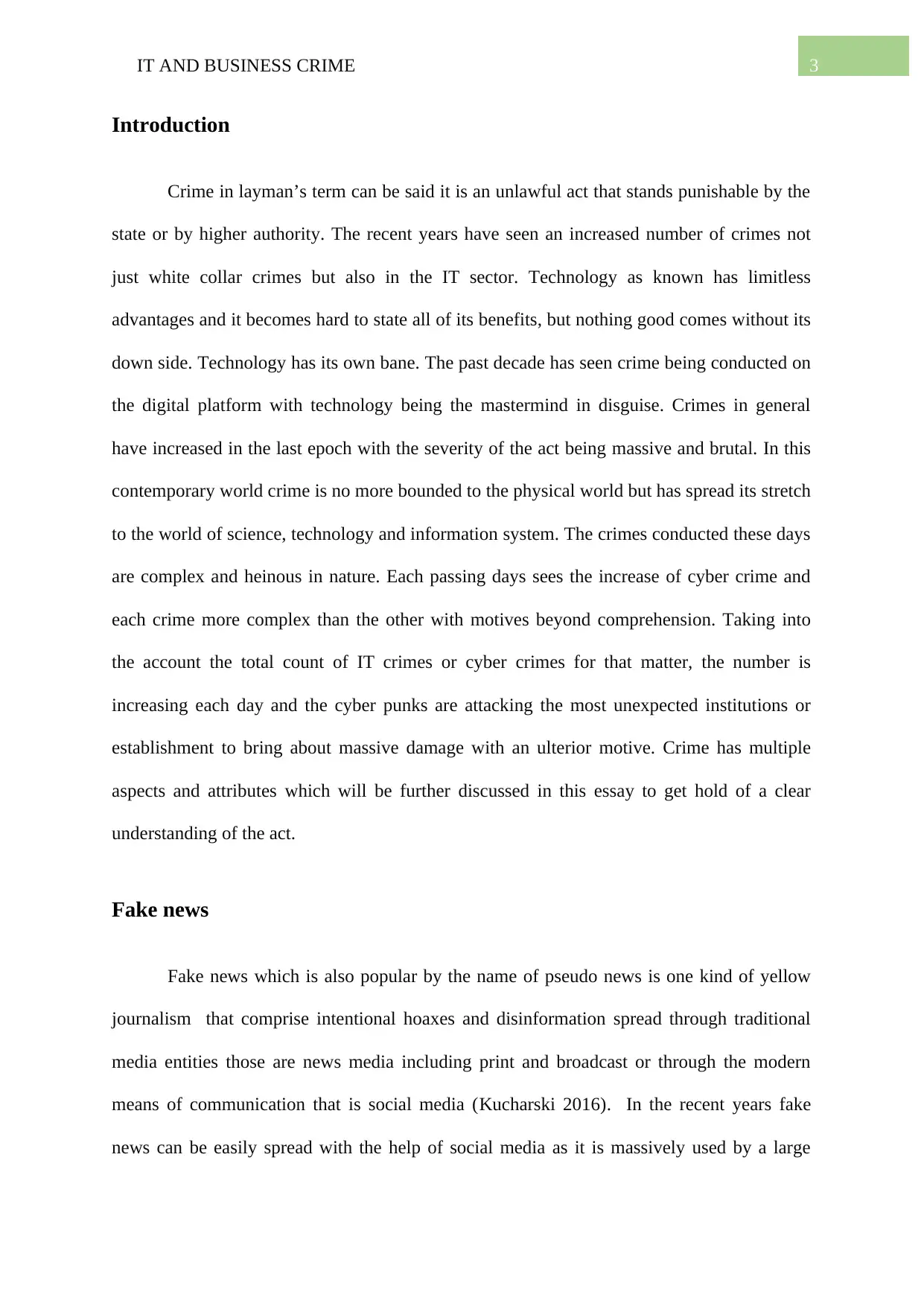
3IT AND BUSINESS CRIME
Introduction
Crime in layman’s term can be said it is an unlawful act that stands punishable by the
state or by higher authority. The recent years have seen an increased number of crimes not
just white collar crimes but also in the IT sector. Technology as known has limitless
advantages and it becomes hard to state all of its benefits, but nothing good comes without its
down side. Technology has its own bane. The past decade has seen crime being conducted on
the digital platform with technology being the mastermind in disguise. Crimes in general
have increased in the last epoch with the severity of the act being massive and brutal. In this
contemporary world crime is no more bounded to the physical world but has spread its stretch
to the world of science, technology and information system. The crimes conducted these days
are complex and heinous in nature. Each passing days sees the increase of cyber crime and
each crime more complex than the other with motives beyond comprehension. Taking into
the account the total count of IT crimes or cyber crimes for that matter, the number is
increasing each day and the cyber punks are attacking the most unexpected institutions or
establishment to bring about massive damage with an ulterior motive. Crime has multiple
aspects and attributes which will be further discussed in this essay to get hold of a clear
understanding of the act.
Fake news
Fake news which is also popular by the name of pseudo news is one kind of yellow
journalism that comprise intentional hoaxes and disinformation spread through traditional
media entities those are news media including print and broadcast or through the modern
means of communication that is social media (Kucharski 2016). In the recent years fake
news can be easily spread with the help of social media as it is massively used by a large
Introduction
Crime in layman’s term can be said it is an unlawful act that stands punishable by the
state or by higher authority. The recent years have seen an increased number of crimes not
just white collar crimes but also in the IT sector. Technology as known has limitless
advantages and it becomes hard to state all of its benefits, but nothing good comes without its
down side. Technology has its own bane. The past decade has seen crime being conducted on
the digital platform with technology being the mastermind in disguise. Crimes in general
have increased in the last epoch with the severity of the act being massive and brutal. In this
contemporary world crime is no more bounded to the physical world but has spread its stretch
to the world of science, technology and information system. The crimes conducted these days
are complex and heinous in nature. Each passing days sees the increase of cyber crime and
each crime more complex than the other with motives beyond comprehension. Taking into
the account the total count of IT crimes or cyber crimes for that matter, the number is
increasing each day and the cyber punks are attacking the most unexpected institutions or
establishment to bring about massive damage with an ulterior motive. Crime has multiple
aspects and attributes which will be further discussed in this essay to get hold of a clear
understanding of the act.
Fake news
Fake news which is also popular by the name of pseudo news is one kind of yellow
journalism that comprise intentional hoaxes and disinformation spread through traditional
media entities those are news media including print and broadcast or through the modern
means of communication that is social media (Kucharski 2016). In the recent years fake
news can be easily spread with the help of social media as it is massively used by a large
Paraphrase This Document
Need a fresh take? Get an instant paraphrase of this document with our AI Paraphraser
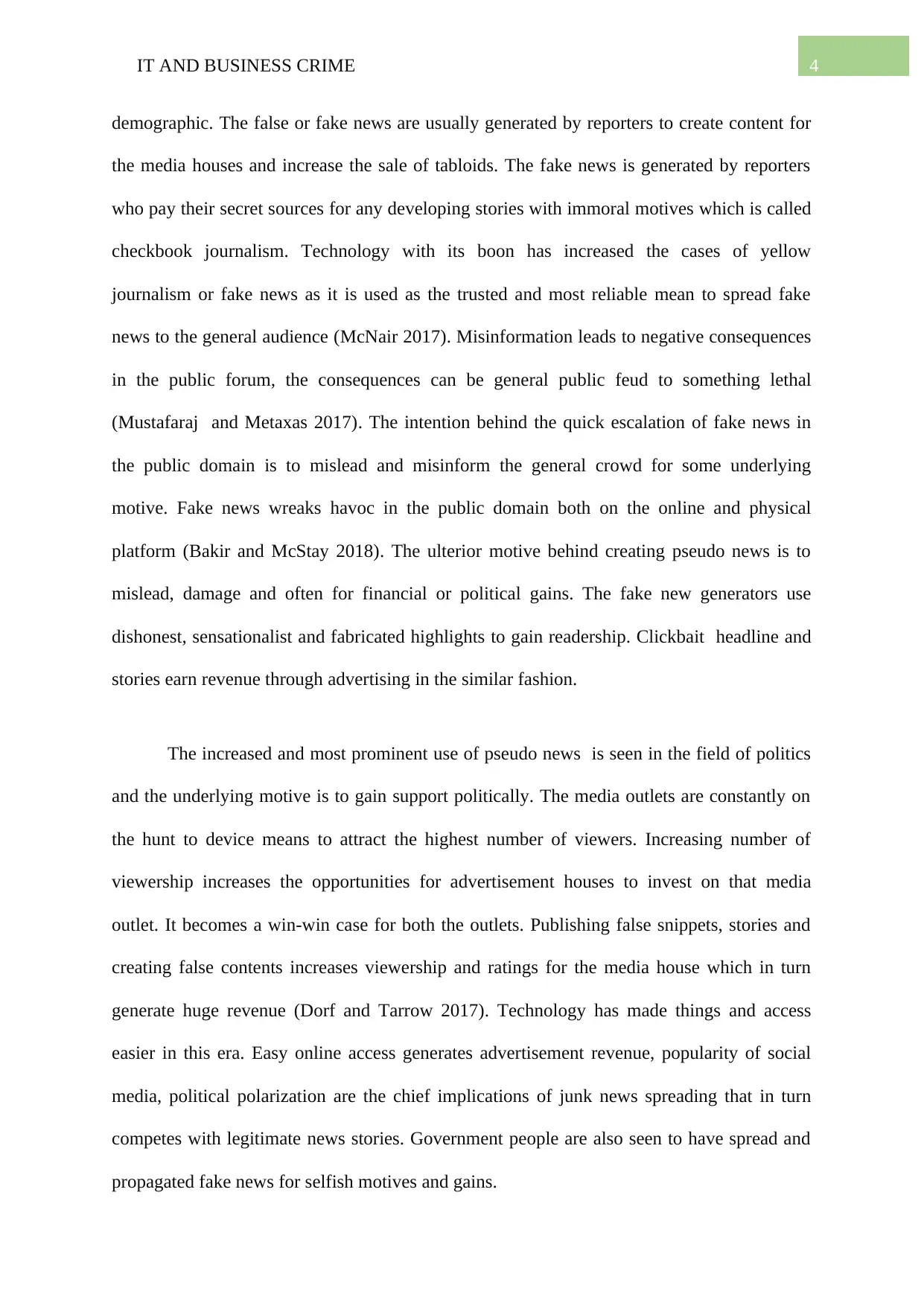
4IT AND BUSINESS CRIME
demographic. The false or fake news are usually generated by reporters to create content for
the media houses and increase the sale of tabloids. The fake news is generated by reporters
who pay their secret sources for any developing stories with immoral motives which is called
checkbook journalism. Technology with its boon has increased the cases of yellow
journalism or fake news as it is used as the trusted and most reliable mean to spread fake
news to the general audience (McNair 2017). Misinformation leads to negative consequences
in the public forum, the consequences can be general public feud to something lethal
(Mustafaraj and Metaxas 2017). The intention behind the quick escalation of fake news in
the public domain is to mislead and misinform the general crowd for some underlying
motive. Fake news wreaks havoc in the public domain both on the online and physical
platform (Bakir and McStay 2018). The ulterior motive behind creating pseudo news is to
mislead, damage and often for financial or political gains. The fake new generators use
dishonest, sensationalist and fabricated highlights to gain readership. Clickbait headline and
stories earn revenue through advertising in the similar fashion.
The increased and most prominent use of pseudo news is seen in the field of politics
and the underlying motive is to gain support politically. The media outlets are constantly on
the hunt to device means to attract the highest number of viewers. Increasing number of
viewership increases the opportunities for advertisement houses to invest on that media
outlet. It becomes a win-win case for both the outlets. Publishing false snippets, stories and
creating false contents increases viewership and ratings for the media house which in turn
generate huge revenue (Dorf and Tarrow 2017). Technology has made things and access
easier in this era. Easy online access generates advertisement revenue, popularity of social
media, political polarization are the chief implications of junk news spreading that in turn
competes with legitimate news stories. Government people are also seen to have spread and
propagated fake news for selfish motives and gains.
demographic. The false or fake news are usually generated by reporters to create content for
the media houses and increase the sale of tabloids. The fake news is generated by reporters
who pay their secret sources for any developing stories with immoral motives which is called
checkbook journalism. Technology with its boon has increased the cases of yellow
journalism or fake news as it is used as the trusted and most reliable mean to spread fake
news to the general audience (McNair 2017). Misinformation leads to negative consequences
in the public forum, the consequences can be general public feud to something lethal
(Mustafaraj and Metaxas 2017). The intention behind the quick escalation of fake news in
the public domain is to mislead and misinform the general crowd for some underlying
motive. Fake news wreaks havoc in the public domain both on the online and physical
platform (Bakir and McStay 2018). The ulterior motive behind creating pseudo news is to
mislead, damage and often for financial or political gains. The fake new generators use
dishonest, sensationalist and fabricated highlights to gain readership. Clickbait headline and
stories earn revenue through advertising in the similar fashion.
The increased and most prominent use of pseudo news is seen in the field of politics
and the underlying motive is to gain support politically. The media outlets are constantly on
the hunt to device means to attract the highest number of viewers. Increasing number of
viewership increases the opportunities for advertisement houses to invest on that media
outlet. It becomes a win-win case for both the outlets. Publishing false snippets, stories and
creating false contents increases viewership and ratings for the media house which in turn
generate huge revenue (Dorf and Tarrow 2017). Technology has made things and access
easier in this era. Easy online access generates advertisement revenue, popularity of social
media, political polarization are the chief implications of junk news spreading that in turn
competes with legitimate news stories. Government people are also seen to have spread and
propagated fake news for selfish motives and gains.
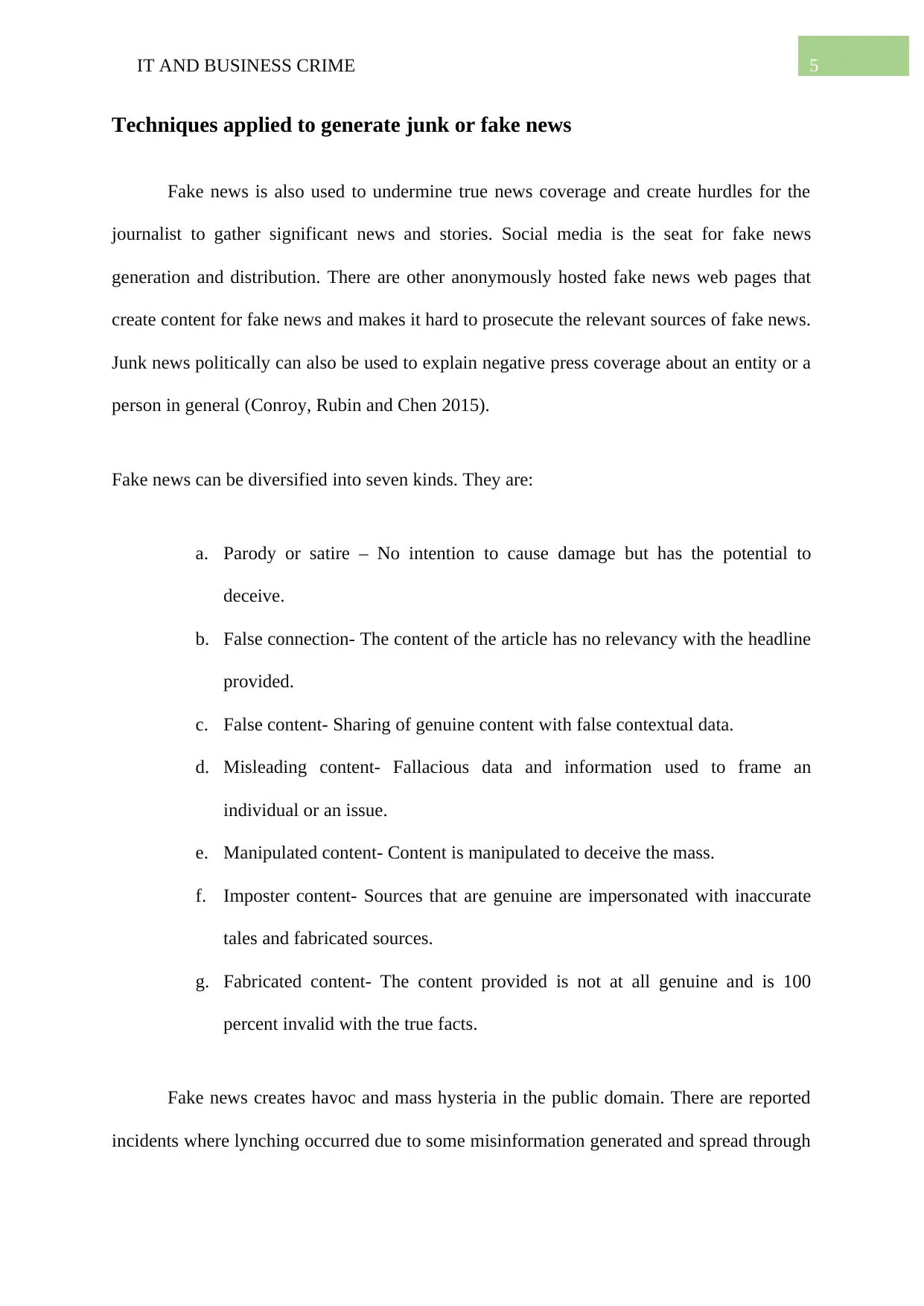
5IT AND BUSINESS CRIME
Techniques applied to generate junk or fake news
Fake news is also used to undermine true news coverage and create hurdles for the
journalist to gather significant news and stories. Social media is the seat for fake news
generation and distribution. There are other anonymously hosted fake news web pages that
create content for fake news and makes it hard to prosecute the relevant sources of fake news.
Junk news politically can also be used to explain negative press coverage about an entity or a
person in general (Conroy, Rubin and Chen 2015).
Fake news can be diversified into seven kinds. They are:
a. Parody or satire – No intention to cause damage but has the potential to
deceive.
b. False connection- The content of the article has no relevancy with the headline
provided.
c. False content- Sharing of genuine content with false contextual data.
d. Misleading content- Fallacious data and information used to frame an
individual or an issue.
e. Manipulated content- Content is manipulated to deceive the mass.
f. Imposter content- Sources that are genuine are impersonated with inaccurate
tales and fabricated sources.
g. Fabricated content- The content provided is not at all genuine and is 100
percent invalid with the true facts.
Fake news creates havoc and mass hysteria in the public domain. There are reported
incidents where lynching occurred due to some misinformation generated and spread through
Techniques applied to generate junk or fake news
Fake news is also used to undermine true news coverage and create hurdles for the
journalist to gather significant news and stories. Social media is the seat for fake news
generation and distribution. There are other anonymously hosted fake news web pages that
create content for fake news and makes it hard to prosecute the relevant sources of fake news.
Junk news politically can also be used to explain negative press coverage about an entity or a
person in general (Conroy, Rubin and Chen 2015).
Fake news can be diversified into seven kinds. They are:
a. Parody or satire – No intention to cause damage but has the potential to
deceive.
b. False connection- The content of the article has no relevancy with the headline
provided.
c. False content- Sharing of genuine content with false contextual data.
d. Misleading content- Fallacious data and information used to frame an
individual or an issue.
e. Manipulated content- Content is manipulated to deceive the mass.
f. Imposter content- Sources that are genuine are impersonated with inaccurate
tales and fabricated sources.
g. Fabricated content- The content provided is not at all genuine and is 100
percent invalid with the true facts.
Fake news creates havoc and mass hysteria in the public domain. There are reported
incidents where lynching occurred due to some misinformation generated and spread through
⊘ This is a preview!⊘
Do you want full access?
Subscribe today to unlock all pages.

Trusted by 1+ million students worldwide
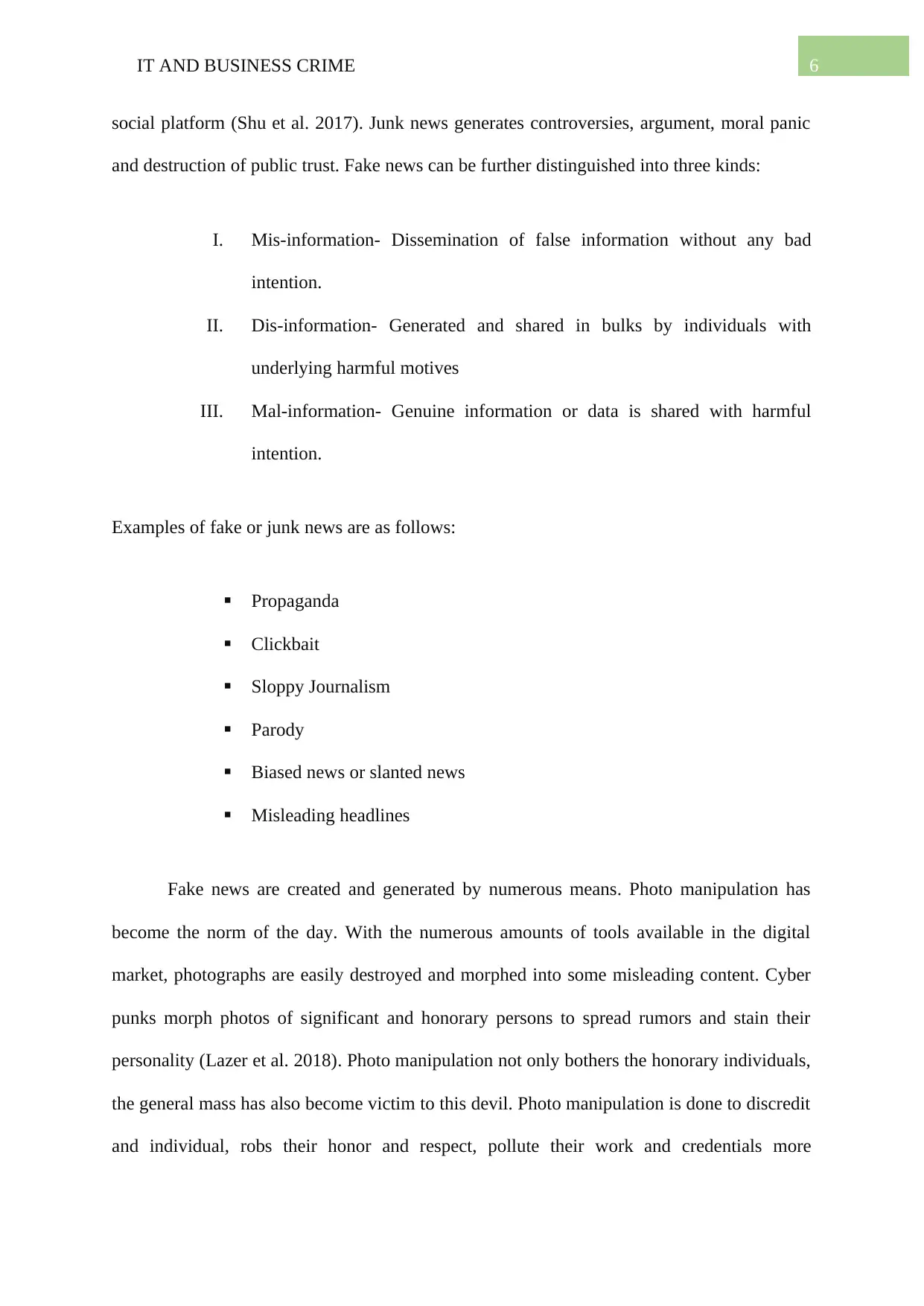
6IT AND BUSINESS CRIME
social platform (Shu et al. 2017). Junk news generates controversies, argument, moral panic
and destruction of public trust. Fake news can be further distinguished into three kinds:
I. Mis-information- Dissemination of false information without any bad
intention.
II. Dis-information- Generated and shared in bulks by individuals with
underlying harmful motives
III. Mal-information- Genuine information or data is shared with harmful
intention.
Examples of fake or junk news are as follows:
Propaganda
Clickbait
Sloppy Journalism
Parody
Biased news or slanted news
Misleading headlines
Fake news are created and generated by numerous means. Photo manipulation has
become the norm of the day. With the numerous amounts of tools available in the digital
market, photographs are easily destroyed and morphed into some misleading content. Cyber
punks morph photos of significant and honorary persons to spread rumors and stain their
personality (Lazer et al. 2018). Photo manipulation not only bothers the honorary individuals,
the general mass has also become victim to this devil. Photo manipulation is done to discredit
and individual, robs their honor and respect, pollute their work and credentials more
social platform (Shu et al. 2017). Junk news generates controversies, argument, moral panic
and destruction of public trust. Fake news can be further distinguished into three kinds:
I. Mis-information- Dissemination of false information without any bad
intention.
II. Dis-information- Generated and shared in bulks by individuals with
underlying harmful motives
III. Mal-information- Genuine information or data is shared with harmful
intention.
Examples of fake or junk news are as follows:
Propaganda
Clickbait
Sloppy Journalism
Parody
Biased news or slanted news
Misleading headlines
Fake news are created and generated by numerous means. Photo manipulation has
become the norm of the day. With the numerous amounts of tools available in the digital
market, photographs are easily destroyed and morphed into some misleading content. Cyber
punks morph photos of significant and honorary persons to spread rumors and stain their
personality (Lazer et al. 2018). Photo manipulation not only bothers the honorary individuals,
the general mass has also become victim to this devil. Photo manipulation is done to discredit
and individual, robs their honor and respect, pollute their work and credentials more
Paraphrase This Document
Need a fresh take? Get an instant paraphrase of this document with our AI Paraphraser
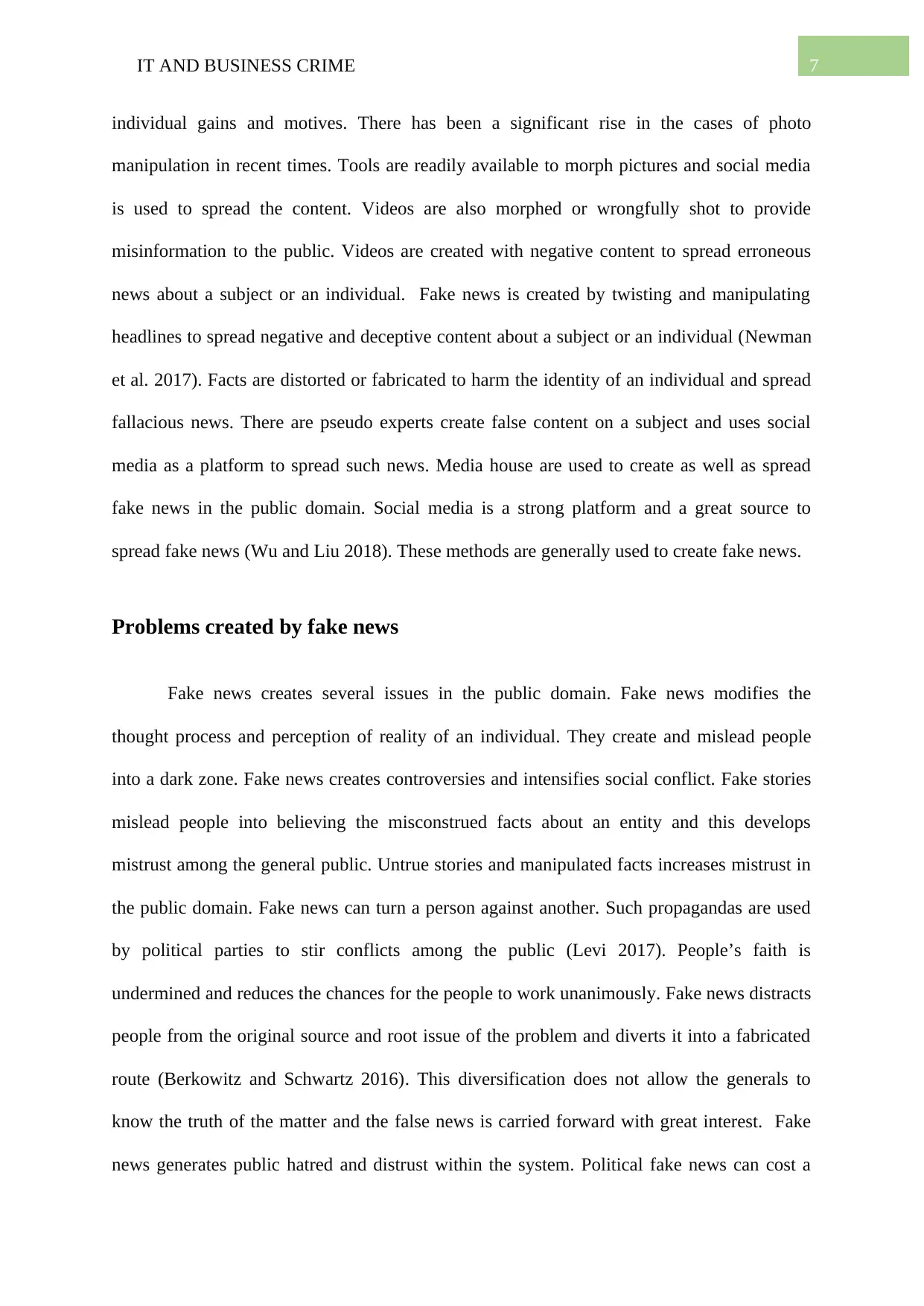
7IT AND BUSINESS CRIME
individual gains and motives. There has been a significant rise in the cases of photo
manipulation in recent times. Tools are readily available to morph pictures and social media
is used to spread the content. Videos are also morphed or wrongfully shot to provide
misinformation to the public. Videos are created with negative content to spread erroneous
news about a subject or an individual. Fake news is created by twisting and manipulating
headlines to spread negative and deceptive content about a subject or an individual (Newman
et al. 2017). Facts are distorted or fabricated to harm the identity of an individual and spread
fallacious news. There are pseudo experts create false content on a subject and uses social
media as a platform to spread such news. Media house are used to create as well as spread
fake news in the public domain. Social media is a strong platform and a great source to
spread fake news (Wu and Liu 2018). These methods are generally used to create fake news.
Problems created by fake news
Fake news creates several issues in the public domain. Fake news modifies the
thought process and perception of reality of an individual. They create and mislead people
into a dark zone. Fake news creates controversies and intensifies social conflict. Fake stories
mislead people into believing the misconstrued facts about an entity and this develops
mistrust among the general public. Untrue stories and manipulated facts increases mistrust in
the public domain. Fake news can turn a person against another. Such propagandas are used
by political parties to stir conflicts among the public (Levi 2017). People’s faith is
undermined and reduces the chances for the people to work unanimously. Fake news distracts
people from the original source and root issue of the problem and diverts it into a fabricated
route (Berkowitz and Schwartz 2016). This diversification does not allow the generals to
know the truth of the matter and the false news is carried forward with great interest. Fake
news generates public hatred and distrust within the system. Political fake news can cost a
individual gains and motives. There has been a significant rise in the cases of photo
manipulation in recent times. Tools are readily available to morph pictures and social media
is used to spread the content. Videos are also morphed or wrongfully shot to provide
misinformation to the public. Videos are created with negative content to spread erroneous
news about a subject or an individual. Fake news is created by twisting and manipulating
headlines to spread negative and deceptive content about a subject or an individual (Newman
et al. 2017). Facts are distorted or fabricated to harm the identity of an individual and spread
fallacious news. There are pseudo experts create false content on a subject and uses social
media as a platform to spread such news. Media house are used to create as well as spread
fake news in the public domain. Social media is a strong platform and a great source to
spread fake news (Wu and Liu 2018). These methods are generally used to create fake news.
Problems created by fake news
Fake news creates several issues in the public domain. Fake news modifies the
thought process and perception of reality of an individual. They create and mislead people
into a dark zone. Fake news creates controversies and intensifies social conflict. Fake stories
mislead people into believing the misconstrued facts about an entity and this develops
mistrust among the general public. Untrue stories and manipulated facts increases mistrust in
the public domain. Fake news can turn a person against another. Such propagandas are used
by political parties to stir conflicts among the public (Levi 2017). People’s faith is
undermined and reduces the chances for the people to work unanimously. Fake news distracts
people from the original source and root issue of the problem and diverts it into a fabricated
route (Berkowitz and Schwartz 2016). This diversification does not allow the generals to
know the truth of the matter and the false news is carried forward with great interest. Fake
news generates public hatred and distrust within the system. Political fake news can cost a
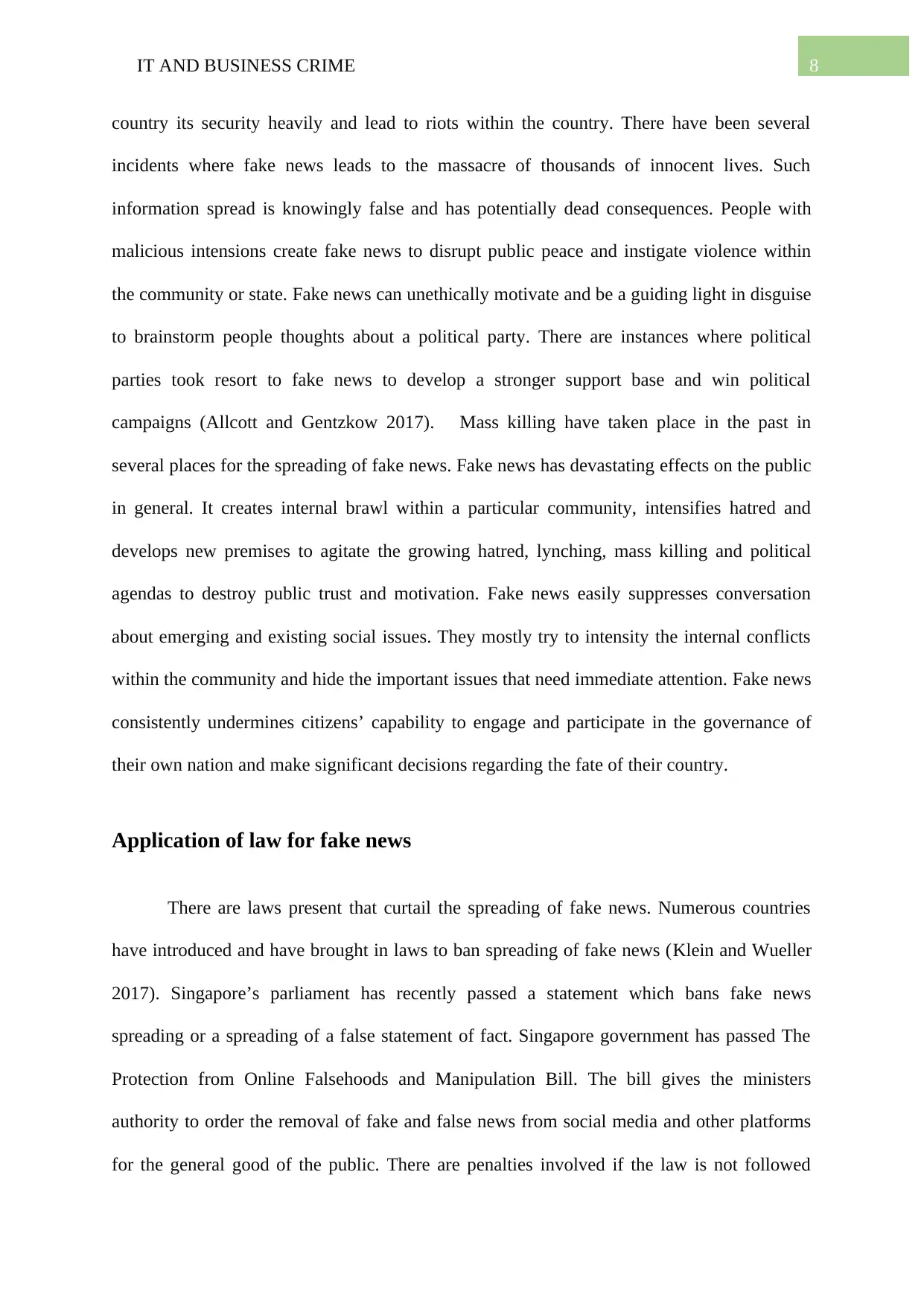
8IT AND BUSINESS CRIME
country its security heavily and lead to riots within the country. There have been several
incidents where fake news leads to the massacre of thousands of innocent lives. Such
information spread is knowingly false and has potentially dead consequences. People with
malicious intensions create fake news to disrupt public peace and instigate violence within
the community or state. Fake news can unethically motivate and be a guiding light in disguise
to brainstorm people thoughts about a political party. There are instances where political
parties took resort to fake news to develop a stronger support base and win political
campaigns (Allcott and Gentzkow 2017). Mass killing have taken place in the past in
several places for the spreading of fake news. Fake news has devastating effects on the public
in general. It creates internal brawl within a particular community, intensifies hatred and
develops new premises to agitate the growing hatred, lynching, mass killing and political
agendas to destroy public trust and motivation. Fake news easily suppresses conversation
about emerging and existing social issues. They mostly try to intensity the internal conflicts
within the community and hide the important issues that need immediate attention. Fake news
consistently undermines citizens’ capability to engage and participate in the governance of
their own nation and make significant decisions regarding the fate of their country.
Application of law for fake news
There are laws present that curtail the spreading of fake news. Numerous countries
have introduced and have brought in laws to ban spreading of fake news (Klein and Wueller
2017). Singapore’s parliament has recently passed a statement which bans fake news
spreading or a spreading of a false statement of fact. Singapore government has passed The
Protection from Online Falsehoods and Manipulation Bill. The bill gives the ministers
authority to order the removal of fake and false news from social media and other platforms
for the general good of the public. There are penalties involved if the law is not followed
country its security heavily and lead to riots within the country. There have been several
incidents where fake news leads to the massacre of thousands of innocent lives. Such
information spread is knowingly false and has potentially dead consequences. People with
malicious intensions create fake news to disrupt public peace and instigate violence within
the community or state. Fake news can unethically motivate and be a guiding light in disguise
to brainstorm people thoughts about a political party. There are instances where political
parties took resort to fake news to develop a stronger support base and win political
campaigns (Allcott and Gentzkow 2017). Mass killing have taken place in the past in
several places for the spreading of fake news. Fake news has devastating effects on the public
in general. It creates internal brawl within a particular community, intensifies hatred and
develops new premises to agitate the growing hatred, lynching, mass killing and political
agendas to destroy public trust and motivation. Fake news easily suppresses conversation
about emerging and existing social issues. They mostly try to intensity the internal conflicts
within the community and hide the important issues that need immediate attention. Fake news
consistently undermines citizens’ capability to engage and participate in the governance of
their own nation and make significant decisions regarding the fate of their country.
Application of law for fake news
There are laws present that curtail the spreading of fake news. Numerous countries
have introduced and have brought in laws to ban spreading of fake news (Klein and Wueller
2017). Singapore’s parliament has recently passed a statement which bans fake news
spreading or a spreading of a false statement of fact. Singapore government has passed The
Protection from Online Falsehoods and Manipulation Bill. The bill gives the ministers
authority to order the removal of fake and false news from social media and other platforms
for the general good of the public. There are penalties involved if the law is not followed
⊘ This is a preview!⊘
Do you want full access?
Subscribe today to unlock all pages.

Trusted by 1+ million students worldwide
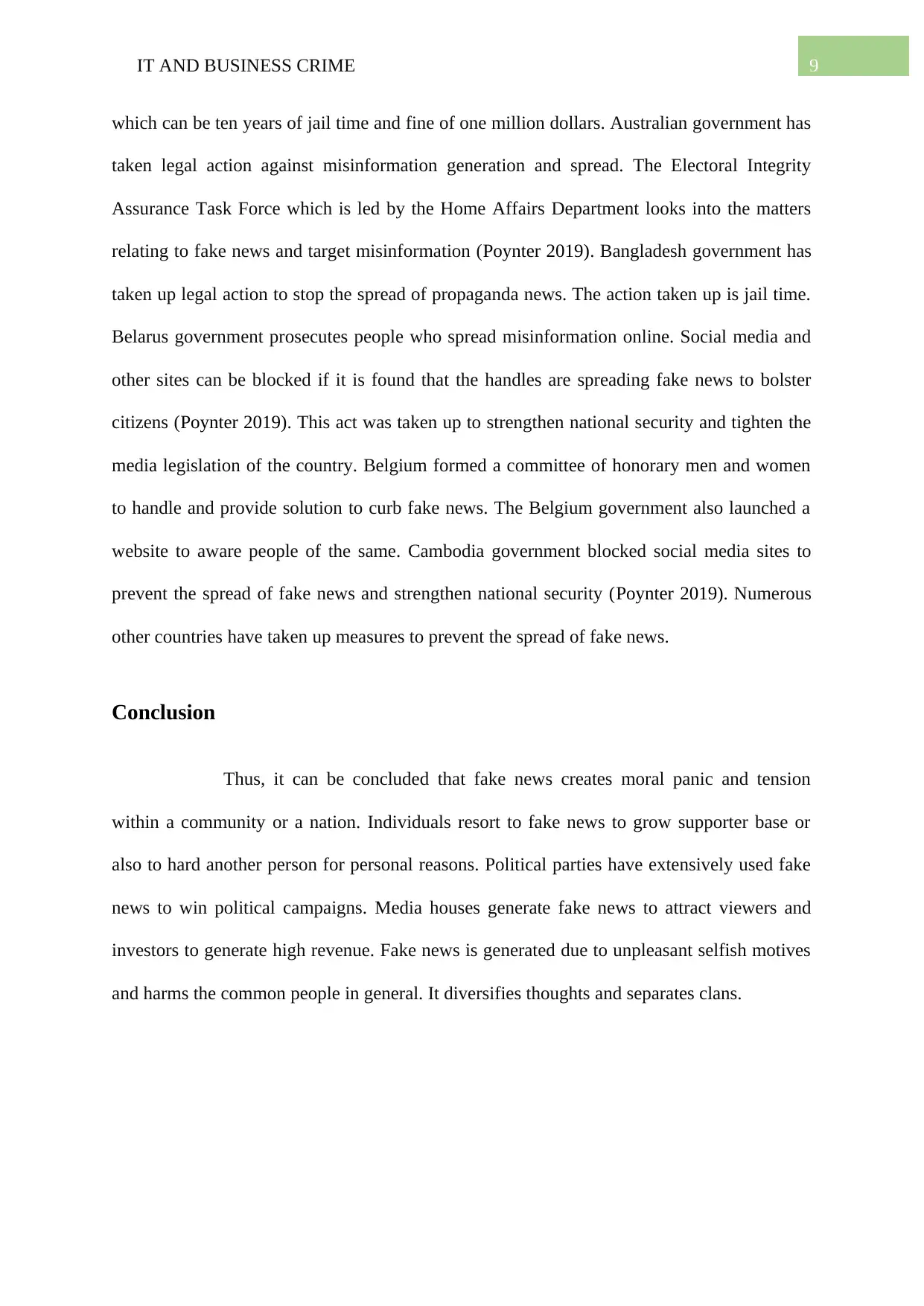
9IT AND BUSINESS CRIME
which can be ten years of jail time and fine of one million dollars. Australian government has
taken legal action against misinformation generation and spread. The Electoral Integrity
Assurance Task Force which is led by the Home Affairs Department looks into the matters
relating to fake news and target misinformation (Poynter 2019). Bangladesh government has
taken up legal action to stop the spread of propaganda news. The action taken up is jail time.
Belarus government prosecutes people who spread misinformation online. Social media and
other sites can be blocked if it is found that the handles are spreading fake news to bolster
citizens (Poynter 2019). This act was taken up to strengthen national security and tighten the
media legislation of the country. Belgium formed a committee of honorary men and women
to handle and provide solution to curb fake news. The Belgium government also launched a
website to aware people of the same. Cambodia government blocked social media sites to
prevent the spread of fake news and strengthen national security (Poynter 2019). Numerous
other countries have taken up measures to prevent the spread of fake news.
Conclusion
Thus, it can be concluded that fake news creates moral panic and tension
within a community or a nation. Individuals resort to fake news to grow supporter base or
also to hard another person for personal reasons. Political parties have extensively used fake
news to win political campaigns. Media houses generate fake news to attract viewers and
investors to generate high revenue. Fake news is generated due to unpleasant selfish motives
and harms the common people in general. It diversifies thoughts and separates clans.
which can be ten years of jail time and fine of one million dollars. Australian government has
taken legal action against misinformation generation and spread. The Electoral Integrity
Assurance Task Force which is led by the Home Affairs Department looks into the matters
relating to fake news and target misinformation (Poynter 2019). Bangladesh government has
taken up legal action to stop the spread of propaganda news. The action taken up is jail time.
Belarus government prosecutes people who spread misinformation online. Social media and
other sites can be blocked if it is found that the handles are spreading fake news to bolster
citizens (Poynter 2019). This act was taken up to strengthen national security and tighten the
media legislation of the country. Belgium formed a committee of honorary men and women
to handle and provide solution to curb fake news. The Belgium government also launched a
website to aware people of the same. Cambodia government blocked social media sites to
prevent the spread of fake news and strengthen national security (Poynter 2019). Numerous
other countries have taken up measures to prevent the spread of fake news.
Conclusion
Thus, it can be concluded that fake news creates moral panic and tension
within a community or a nation. Individuals resort to fake news to grow supporter base or
also to hard another person for personal reasons. Political parties have extensively used fake
news to win political campaigns. Media houses generate fake news to attract viewers and
investors to generate high revenue. Fake news is generated due to unpleasant selfish motives
and harms the common people in general. It diversifies thoughts and separates clans.
Paraphrase This Document
Need a fresh take? Get an instant paraphrase of this document with our AI Paraphraser
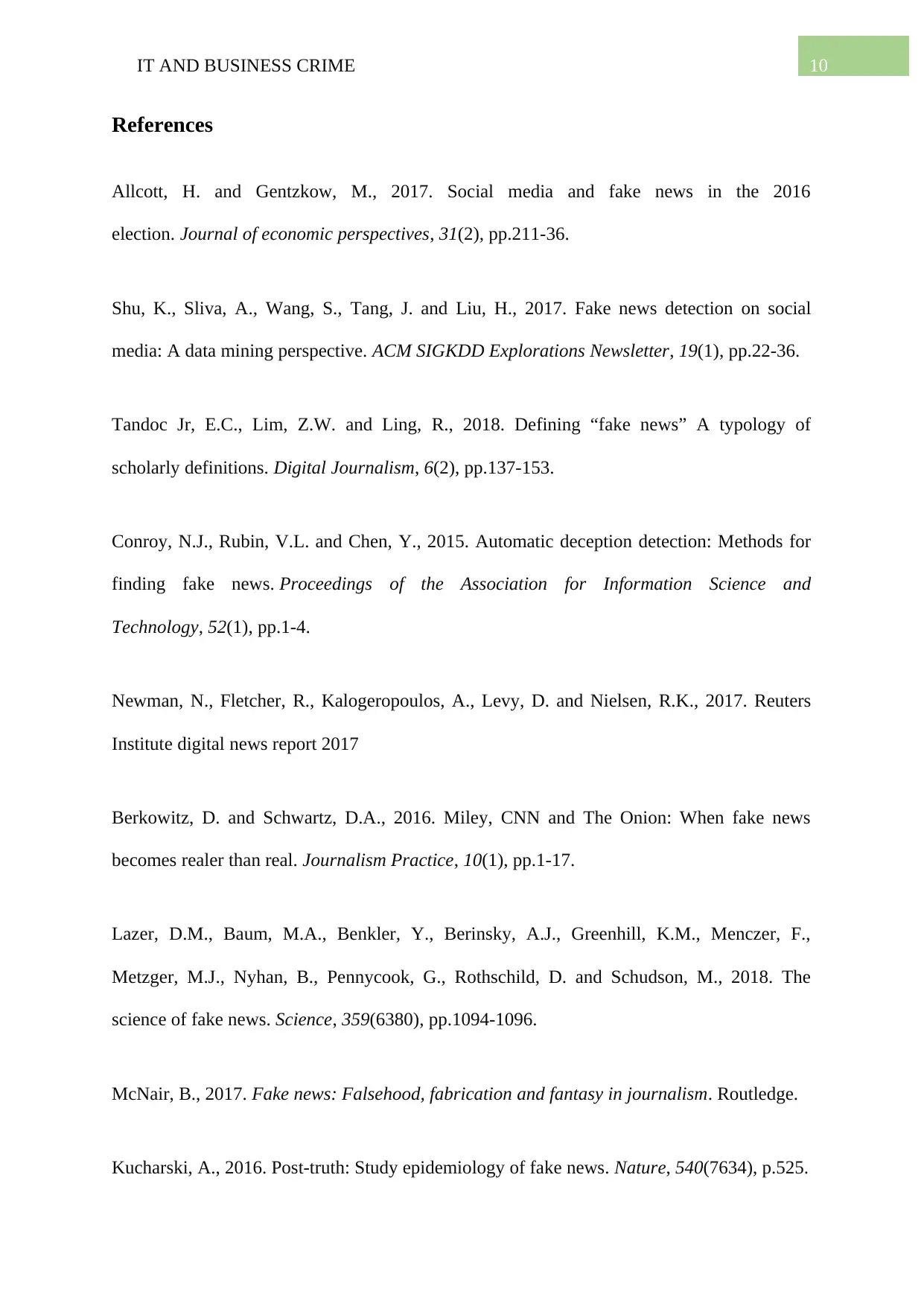
10IT AND BUSINESS CRIME
References
Allcott, H. and Gentzkow, M., 2017. Social media and fake news in the 2016
election. Journal of economic perspectives, 31(2), pp.211-36.
Shu, K., Sliva, A., Wang, S., Tang, J. and Liu, H., 2017. Fake news detection on social
media: A data mining perspective. ACM SIGKDD Explorations Newsletter, 19(1), pp.22-36.
Tandoc Jr, E.C., Lim, Z.W. and Ling, R., 2018. Defining “fake news” A typology of
scholarly definitions. Digital Journalism, 6(2), pp.137-153.
Conroy, N.J., Rubin, V.L. and Chen, Y., 2015. Automatic deception detection: Methods for
finding fake news. Proceedings of the Association for Information Science and
Technology, 52(1), pp.1-4.
Newman, N., Fletcher, R., Kalogeropoulos, A., Levy, D. and Nielsen, R.K., 2017. Reuters
Institute digital news report 2017
Berkowitz, D. and Schwartz, D.A., 2016. Miley, CNN and The Onion: When fake news
becomes realer than real. Journalism Practice, 10(1), pp.1-17.
Lazer, D.M., Baum, M.A., Benkler, Y., Berinsky, A.J., Greenhill, K.M., Menczer, F.,
Metzger, M.J., Nyhan, B., Pennycook, G., Rothschild, D. and Schudson, M., 2018. The
science of fake news. Science, 359(6380), pp.1094-1096.
McNair, B., 2017. Fake news: Falsehood, fabrication and fantasy in journalism. Routledge.
Kucharski, A., 2016. Post-truth: Study epidemiology of fake news. Nature, 540(7634), p.525.
References
Allcott, H. and Gentzkow, M., 2017. Social media and fake news in the 2016
election. Journal of economic perspectives, 31(2), pp.211-36.
Shu, K., Sliva, A., Wang, S., Tang, J. and Liu, H., 2017. Fake news detection on social
media: A data mining perspective. ACM SIGKDD Explorations Newsletter, 19(1), pp.22-36.
Tandoc Jr, E.C., Lim, Z.W. and Ling, R., 2018. Defining “fake news” A typology of
scholarly definitions. Digital Journalism, 6(2), pp.137-153.
Conroy, N.J., Rubin, V.L. and Chen, Y., 2015. Automatic deception detection: Methods for
finding fake news. Proceedings of the Association for Information Science and
Technology, 52(1), pp.1-4.
Newman, N., Fletcher, R., Kalogeropoulos, A., Levy, D. and Nielsen, R.K., 2017. Reuters
Institute digital news report 2017
Berkowitz, D. and Schwartz, D.A., 2016. Miley, CNN and The Onion: When fake news
becomes realer than real. Journalism Practice, 10(1), pp.1-17.
Lazer, D.M., Baum, M.A., Benkler, Y., Berinsky, A.J., Greenhill, K.M., Menczer, F.,
Metzger, M.J., Nyhan, B., Pennycook, G., Rothschild, D. and Schudson, M., 2018. The
science of fake news. Science, 359(6380), pp.1094-1096.
McNair, B., 2017. Fake news: Falsehood, fabrication and fantasy in journalism. Routledge.
Kucharski, A., 2016. Post-truth: Study epidemiology of fake news. Nature, 540(7634), p.525.
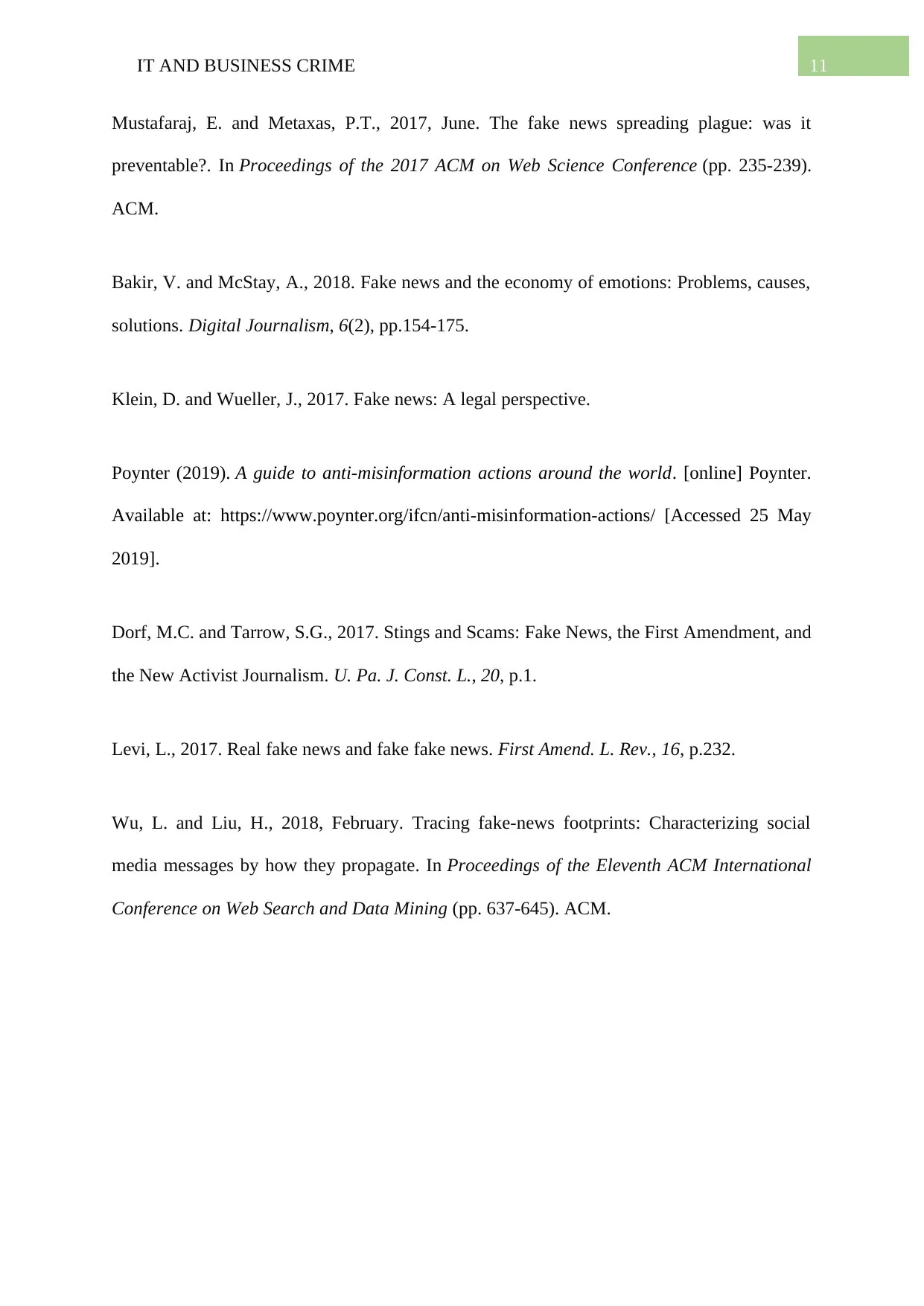
11IT AND BUSINESS CRIME
Mustafaraj, E. and Metaxas, P.T., 2017, June. The fake news spreading plague: was it
preventable?. In Proceedings of the 2017 ACM on Web Science Conference (pp. 235-239).
ACM.
Bakir, V. and McStay, A., 2018. Fake news and the economy of emotions: Problems, causes,
solutions. Digital Journalism, 6(2), pp.154-175.
Klein, D. and Wueller, J., 2017. Fake news: A legal perspective.
Poynter (2019). A guide to anti-misinformation actions around the world. [online] Poynter.
Available at: https://www.poynter.org/ifcn/anti-misinformation-actions/ [Accessed 25 May
2019].
Dorf, M.C. and Tarrow, S.G., 2017. Stings and Scams: Fake News, the First Amendment, and
the New Activist Journalism. U. Pa. J. Const. L., 20, p.1.
Levi, L., 2017. Real fake news and fake fake news. First Amend. L. Rev., 16, p.232.
Wu, L. and Liu, H., 2018, February. Tracing fake-news footprints: Characterizing social
media messages by how they propagate. In Proceedings of the Eleventh ACM International
Conference on Web Search and Data Mining (pp. 637-645). ACM.
Mustafaraj, E. and Metaxas, P.T., 2017, June. The fake news spreading plague: was it
preventable?. In Proceedings of the 2017 ACM on Web Science Conference (pp. 235-239).
ACM.
Bakir, V. and McStay, A., 2018. Fake news and the economy of emotions: Problems, causes,
solutions. Digital Journalism, 6(2), pp.154-175.
Klein, D. and Wueller, J., 2017. Fake news: A legal perspective.
Poynter (2019). A guide to anti-misinformation actions around the world. [online] Poynter.
Available at: https://www.poynter.org/ifcn/anti-misinformation-actions/ [Accessed 25 May
2019].
Dorf, M.C. and Tarrow, S.G., 2017. Stings and Scams: Fake News, the First Amendment, and
the New Activist Journalism. U. Pa. J. Const. L., 20, p.1.
Levi, L., 2017. Real fake news and fake fake news. First Amend. L. Rev., 16, p.232.
Wu, L. and Liu, H., 2018, February. Tracing fake-news footprints: Characterizing social
media messages by how they propagate. In Proceedings of the Eleventh ACM International
Conference on Web Search and Data Mining (pp. 637-645). ACM.
⊘ This is a preview!⊘
Do you want full access?
Subscribe today to unlock all pages.

Trusted by 1+ million students worldwide
1 out of 12
Related Documents
Your All-in-One AI-Powered Toolkit for Academic Success.
+13062052269
info@desklib.com
Available 24*7 on WhatsApp / Email
![[object Object]](/_next/static/media/star-bottom.7253800d.svg)
Unlock your academic potential
Copyright © 2020–2025 A2Z Services. All Rights Reserved. Developed and managed by ZUCOL.




